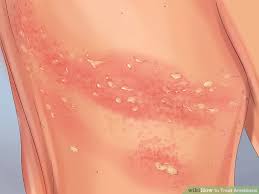AMEBIASIS

What is amebiasis?
Amebiasis is a parasitic infection caused by the protozoon Entamoeba histolytica. Amebiasis is the 3rd leading parasitic cause of death worldwide and affects several body systems. In generalized amebiasis the parasite infects the gastrointestinal tract causing diarrhea and bloody stools. Occasionally the parasite can infect extraintestinal sites such as the liver, heart, lungs and skin. Here we will discuss cutaneous amebiasis. In cutaneous amebiasis the parasites invades the skin tissue causing ulcerations, nodules and abscesses. Patients may also have genital lesions that have a punched-out appearance and abundant discharge.
What causes amebiasis?
Amebiasis infection occurs via a fecal-oral route through consumption of food or water contaminated by excrement. Once ingested, the parasite breaks out of its cyst (excystation) and invades the small bowel and colon leading to destruction of the cells lining the intestines. The parasites can then enter the blood stream and invade the liver and other organs, including skin.
How is amebiasis treated?
Amebiasis can be treated with anti-parasitic agents such as paromomycin, iodoquinol and metronidazole (for invasive amebiasis).


